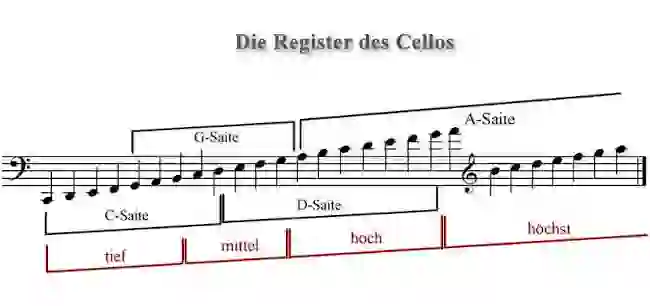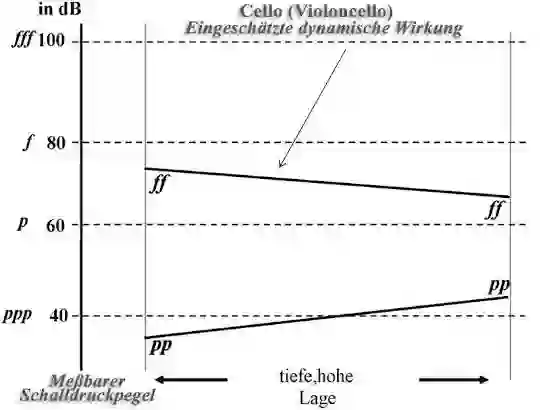Sound character of the Cello - Philipp Dangas
Cello register table
The cello is the homogeneous partner of the violin in the lower and middle range of the orchestral scale. The sound of the violin can be compared to that of the female voice and the sound of the cello to that of the male voice. The cello's range of expression is extensive. It ranges from the tragic seriousness and sublime solemnity of the lower register to the excessive passion of the high and highest registers. The transition between the individual sound registers is completely smooth. Slight differences in the tonal character of the individual strings can be compensated for by using the upper positions of the strings.
As part of the „symphonic world music“ the cello is a main instrument of the string section. The main task of the cello is to create the overall sound. They are generally used as a unified group, but are sometimes divided into divisions or stands to simultaneously perform different functions, such as reinforcing both melody and rhythm.
[download size: 768 kilobytes]
Table summary of the sound character of the cello
The following table shows the timbres of the cello briefly described. And the sound character it creates.
Dynamic effect of the cello
Sheet music for the dynamic table from the celloIn the following dynamic table it shows the levels of musical dynamics. In addition to the sound pressure scale measured in decibels [dB], the degrees of strength of musical dynamics are given on the left, which can be understood as "objective" degrees.
A diagram is drawn. To the right of the dB scale, fairly easy to see. It shows the estimated dynamic effect over the entire tonal range of the instrument. The dynamic effect (volume) as judged (perceived) by the listener.
Now let's consider the following example: The trumpet in the low register has a dynamic range between pianissimo [pp] 46 decibels [dB] and fortissimo [ff] 82 decibels [dB] = 36 decibels [dB]. In the high register, the range is 8 decibels [dB]. The estimated values can deviate more or less from the "objective" ones.
Deviations, which of course vary from instrument to instrument. The mentioned "objective" levels of intensity piano pianissimo [ppp]= 40 decibels [dB], p=60 decibels [dB] etc. enable the composer to predict the dynamic effects of different instruments that are sounding simultaneously.
Table summary of the dynamic range of the cello
The following table shows the achievable dynamic range of the cello. The span is the difference between the fortissimo and the pianissimo in the same pitch.

The register table of the cello in large format
- A String
- Good for solo passages, sounds m most brilliant.
- D String
- Suitable for lyrical lines. Soft, warm sound.
- G String
- VComparatively the weakest, but still strong.
- C String
- Possesses real bass quality and sonority.

The dynamic table of the cello
Internal search function
| Name | Value | Delete |
|---|